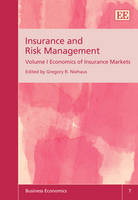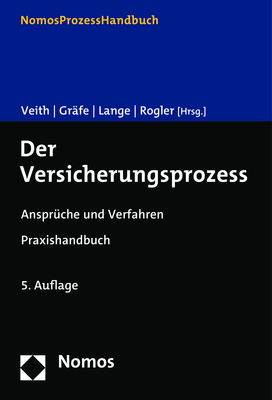
Insurance and Risk Management
Edward Elgar Publishing Ltd (Verlag)
978-1-84720-333-5 (ISBN)
There is a broad range of literature on the economics of insurance and risk management. This timely publication contains recent theoretical contributions to the economics of insurance and presents empirical tests and applications of the theory to many different insurance markets. It also offers important insights into the factors influencing corporate risk management decisions, and the theoretical underpinnings for why corporations with well-diversified shareholders would reduce risk. This two-volume set will be an essential resource to everyone with an interest in these important subjects.
Edited by Gregory R. Niehaus, Professor of Finance and Insurance and Associate Dean for Research and Academics, Moore School of Business, University of South Carolina, US
Contents:
Volume I: Economics of Insurance Markets
Acknowledgements
Introduction Gregory R. Niehaus
PART IRISK POOLING, INSURER CAPITAL AND OWNERSHIP STRUCTURE
1. John M. Marshall (1974), ‘Insurance Theory: Reserves versus Mutuality’
2. George Zanjani (2002), ‘Pricing and Capital Allocation in Catastrophe Insurance’
3. Lawrence A. Berger, J. David Cummins and Sharon Tennyson (1992), ‘Reinsurance and the Liability Insurance Crisis’
4. David Mayers and Clifford Smith (1988), ‘Ownership Structure Across Lines of Property-Casualty Insurance’
5. Bruce D. Smith and Michael Stutzer (1995), ‘A Theory of Mutual Formation and Moral Hazard with Evidence from the History of the Insurance Industry’
PART IIADVERSE SELECTION AND CLASSIFICATION
6. Alma Cohen (2005), ‘Asymmetric Information and Learning: Evidence from the Automobile Insurance Market’
7. John Cawley and Tomas Philipson (1999), ‘An Empirical Examination of Information Barriers to Trade in Insurance’
8. Georges Dionne and Neil A. Doherty (1994), ‘Adverse Selection, Commitment, and Renegotiation: Extension to and Evidence from Insurance Markets’
9. Keith J. Crocker and Arthur Snow (1986), ‘The Efficiency Effects of Categorical Discrimination in the Insurance Industry’
10. Eric W. Bond and Keith J. Crocker (1991), ‘Smoking, Skydiving, and Knitting: The Endogenous Categorization of Risks in Insurance Markets with Asymmetric Information’
11. Michael Hoy and Michael Ruse (2005), ‘Regulating Genetic Information in Insurance Markets’
PART IIIPRICING AND UNDERWRITING CYCLES
12. Ralph A. Winter (1994), ‘The Dynamics of Competitive Insurance Markets’
13. J. David Cummins and Patricia Danzon (1997), ‘Price, Financial Quality, and Capital Flows in Insurance Markets’
14. Scott E. Harrington and Patricia M. Danzon (1994), ‘Price Cutting in Liability Insurance Markets’
PART IVMISCELLANEOUS PUBLIC POLICY ISSUES
15. Scott E. Harrington and Greg Niehaus (1998), ‘Race, Redlining, and Automobile Insurance Prices’
16. J. David Cummins, Richard D. Phillips and Mary A. Weiss (2001), ‘The Incentive Effects of No-Fault Automobile Insurance’
17. Anthony J. Barkume and John W. Ruser (2001), ‘Deregulating Property-Casualty Insurance Pricing: The Case of Workers' Compensation’
18. John H. Cochrane (1995), ‘Time-Consistent Health Insurance’
Name Index
Volume II: Corporate Risk Management
Acknowledgements
An introduction by the editor to both volumes appears in Volume I
PART I THEORY ON WHY AND HOW FIRMS MANAGE RISK
1. David Mayers and Clifford W. Smith, Jr. (1982), ‘On the Corporate Demand for Insurance’
2. Clifford W. Smith and René M. Stulz (1985), ‘The Determinants of Firms’ Hedging Policies’
3. Kenneth A. Froot, David S. Scharfstein and Jeremy C. Stein (1993), ‘Risk Management: Coordinating Corporate Investment and Financing Policies’
4. Peter M. DeMarzo and Darrell Duffie (1995), ‘Corporate Incentives for Hedging and Hedge Accounting’
5. Gregory W. Brown and Klaus Bjerre Toft (2002), ‘How Firms Should Hedge’
6. Frank Fehle and Sergey Tsyplakov (2005), ‘Dynamic Risk Management: Theory and Evidence’
PART IIEMPIRICAL EVIDENCE ON WHY AND HOW FIRMS MANAGE RISK
7. David Mayers and Clifford W. Smith, Jr. (1990), ‘On the Corporate Demand for Insurance: Evidence from the Reinsurance Market’
8. Christopher Géczy, Bernadette A. Minton and Catherine Schrand (1997), ‘Why Firms Use Currency Derivatives’
9. Michael Faulkender (2005), ‘Hedging or Market Timing? Selecting the Interest Rate Exposure of Corporate Debt’
10. John R. Graham and Clifford W. Smith, Jr. (1999), ‘Tax Incentives to Hedge’
11. George Allayannis and James P. Weston (2001), ‘The Use of Foreign Currency Derivatives and Firm Market Value’
12. Peter Tufano (1996), ‘Who Manages Risk? An Empirical Examination of Risk Management Practices in the Gold Mining Industry’
13. Yanbo Jin and Philippe Jorion (2006), ‘Firm Value and Hedging: Evidence from U.S. Oil and Gas Producers’
PART IIIMEASURING RISK AND ENTERPRISE RISK MANAGEMENT
14. Kevin Dowd and David Blake (2006), ‘After VaR: The Theory, Estimation, and Insurance Applications of Quantile-Based Risk Measures’
15. Joshua V. Rosenberg and Til Schuermann (2006), ‘A General Approach to Integrated Risk Management with Skewed, Fat-tailed Risks’
16. Scott E. Harrington, Greg Niehaus and Kenneth J. Risko (2002), ‘Enterprise Risk Management: The Case of United Grain Growers’
Name Index
| Erscheint lt. Verlag | 31.10.2008 |
|---|---|
| Reihe/Serie | Business Economics series |
| Verlagsort | Cheltenham |
| Sprache | englisch |
| Maße | 169 x 244 mm |
| Themenwelt | Betriebswirtschaft / Management ► Spezielle Betriebswirtschaftslehre ► Versicherungsbetriebslehre |
| ISBN-10 | 1-84720-333-7 / 1847203337 |
| ISBN-13 | 978-1-84720-333-5 / 9781847203335 |
| Zustand | Neuware |
| Haben Sie eine Frage zum Produkt? |
aus dem Bereich


